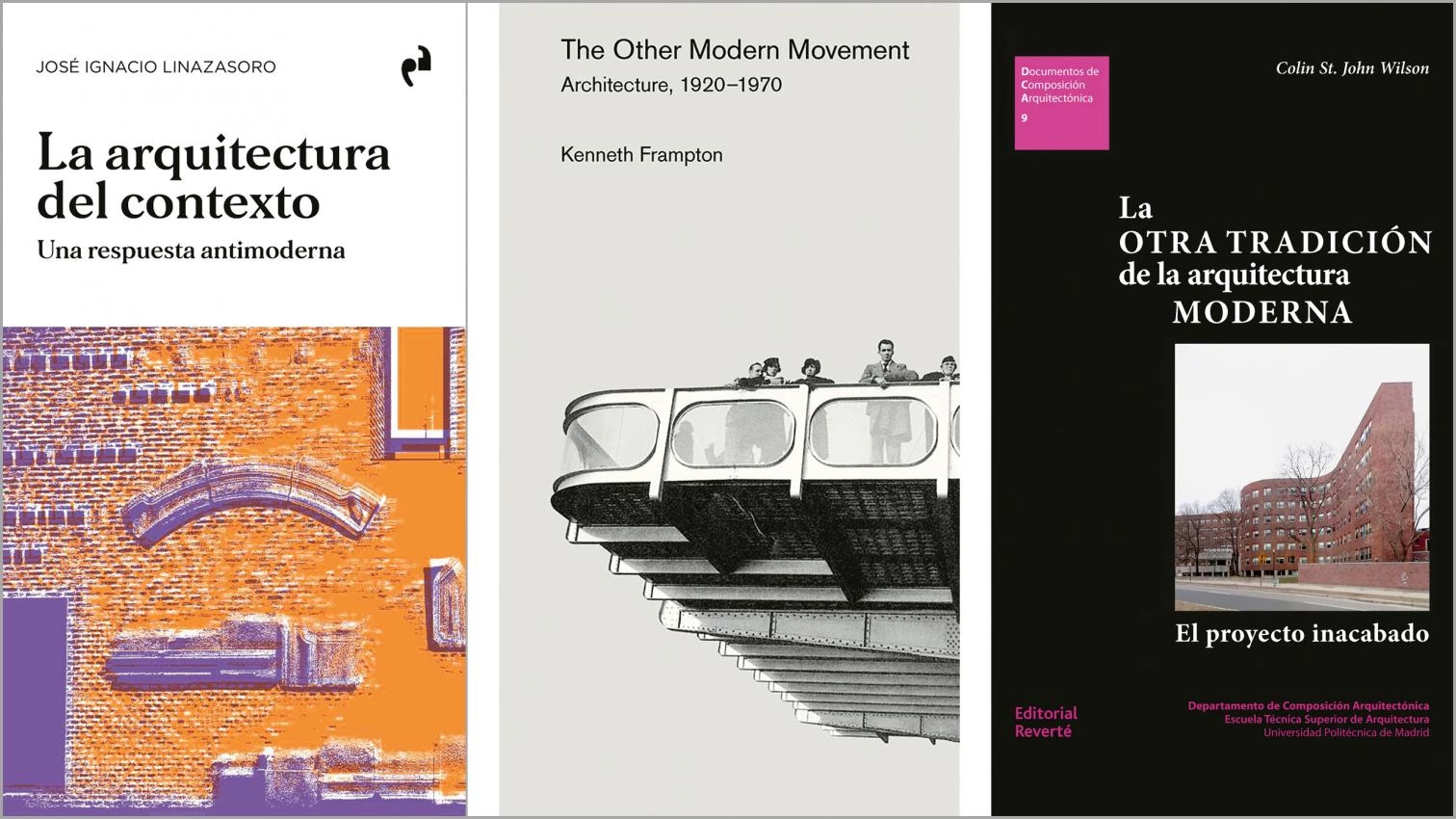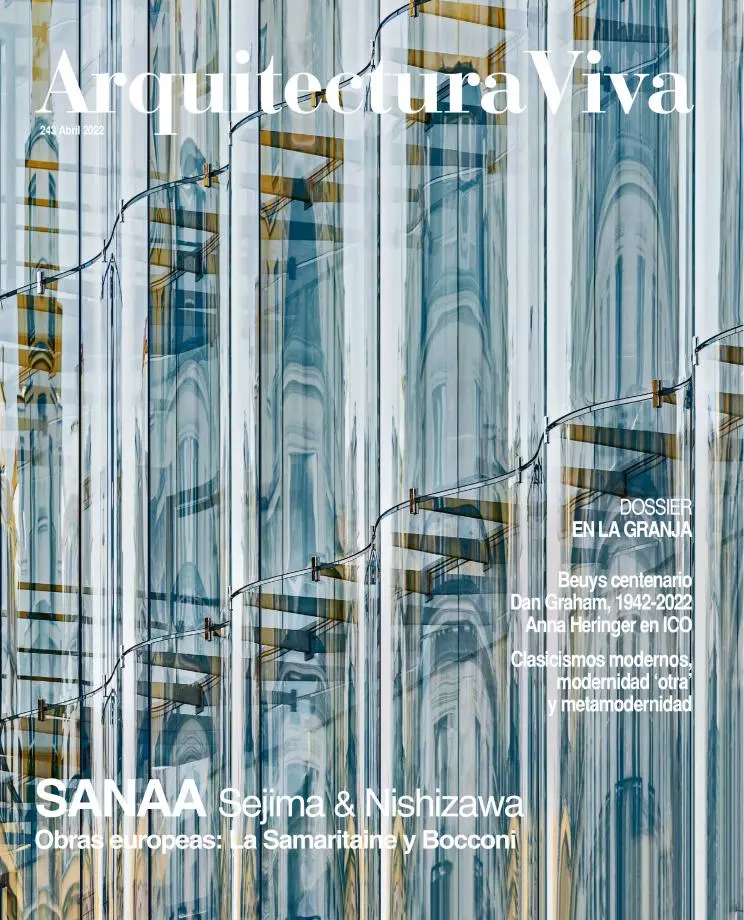
The simultaneous release in 2021 of translations of books by Colin St John Wilson and Kenneth Frampton, both on dissident modernities, is reason to revise the architectural canons of the past century, and a coinciding volume by José Ignacio Linazasoro, presented as an ‘antimodern answer,’ brings the revision a step further. Wilson’s work, The Other Tradition of Modern Architecture: The Uncompleted Project, was originally published in 1995, and to its 2007 edition the Spanish version adds a prologue and an epilogue that serve to put the British architect’s vibrant allegations in context; Frampton’s, for its part, first came out in Italian, in 2015, as L’altro Movimento Moderno, and the English version adds a subtitle – Architecture, 1920-1970 – that establishes the time scope of the eminent historian’s 18 essays on less-known figures. Both volumes seek to rescue ‘the other modernity,’ but with different approaches: if Wilson’s is a polemical text dedicated to ‘the members of the resistance’ and centered on explaining ‘what went wrong’ from the very first moments of the Modern Movement, Frampton’s is an informative and analytical compendium that presents each of the selected figures through a short biography, followed by a commentary on a representative work. As for Linazasoro’s La arquitectura del contexto, it reads as a full amendment of the movement; his texts cruise through 20th-century architecture in an impressionistic way, annotating works and authors he considers critical of modernity, but his cast of characters in the end is not too different from those of the British authors.
An Angry Manifesto
The trajectory of ‘Sandy’ Wilson (1922-2007) is inseparable from his three-decade attention to the colossal and ill-starred project for the new British Library, which he called “my 30-year war,” but it would perhaps be remembered in a better light with this defiant, controversial book, published a few years after he retired from his professorship at Cambridge University, a true intellectual testament. In his opinion, modernity derailed in 1928, when Le Corbusier and Sigfried Giedion imposed their ideological and formal authority at the first CIAM meeting in La Sarraz. “The ‘Open Hand’ – he wrote – was always ready to become a closed fist.” The pioneer of the ‘resistance’ was Hugo Häring, but its most prominent member in the long run would be Alvar Aalto, whose speech at the RIBA in 1957 opened Wilson’s eyes to the deviation of a modernity that was not keeping its promises. These two masters are essential references in the book, together with Hans Scharoun and Eileen Gray, followed by Erik Gunnar Asplund, Sigurd Lewerentz, Ernst May, Jan Duiker, or his contemporary Giancarlo de Carlo, and several of them are weighed up against Mies van der Rohe, Walter Gropius, Arne Jacobsen, or Le Corbusier in the last-chapter comparisons of projects for city halls, art galleries, student residences, and houses: case studies where orthodox modernity is on the losing end, and where examples like Gray’s E-1027 serve to prevent this other tradition from being associated with expressionism or organicism.
Expanded History
Some of these architects – Gray, Lewerentz, or Duiker – also figure in Frampton’s selection, guided likewise by the philosopher Jürgen Habermas’s reflections on modernity as an unfinished project, but where the essential criteria have been “the relative marginality of each protagonist” and “the degree to which the work has contributed to the making of a new typology.” Of course the marginal position of figures like Rudolf Schindler, Erich Mendelsohn, Arne Jacobsen, or Richard Neutra is only relative, and it is easier to find it in architects like the Belgian Louis Herman De Koninck, the British Evan Owen Williams, the Austria-born Czech Jaromír Krejcar (whose 1937 Paris pavilion illustrates the cover), the Dane Vilhelm Lauritzen, or the Swiss Werner Moser and Max Ernst Haefeli, but all of them made important contributions, and the documentation gathered in the volume will be of help in profiling his presence in the histories of the 20th century. Frampton traces the origins of the ‘other’ modernity, opposed to the doctrinaire functionalism of the postwar, to the colloquium that took place in Darmstadt in 1951, where Scharoun’s school project for that city and Martin Heidegger’s mythical text, Bauen Wohnen Denken, were presented. The idea of an alternative modernity would be proposed anew, in other terms, at the Venice Biennale of 1980, under the heading ‘The Presence of the Past,’ a populist postmodernity refuted in 1982 by the Munich exhibition ‘Die andere Tradition’ – which kicked off with a speech in which Habermas reiterated his conviction that modernity was an unfinished project – and in 1985 by ‘Die andere Moderne,’ a show about the work of the Swiss architect Otto Rudolf Salvisberg. Both were precedents of Wilsons’s book of 1995 and Frampton’s of 2015, which, incidentally, closes with Alejandro de la Sota, whose late presence is associated with the delay of Spanish modernization by the Civil War. In his introduction, the historian laments the absence of German Swiss like the mentioned Salvisberg or the eccentric Karl Egender; Scandinavians like the Norwegian Arne Korsmo and the Finnish Erik Bryggmann; Greeks like Patroklos Karantinòs, Dimitris Pikionis, Aris Konstantinidis, or Takis Zenetos; and Italians like Luigi Moretti, Eugenio Montuori, or Annibale Vitellozzi. If we add three or four Spaniards, Kenneth Frampton – in top form and retired from Columbia University since a year ago, when he turned 90 – has material for a formidable new volume.
Personal References
The San Sebastián-born professor and architect, for his part, expands ideas formulated in his 2013 book, La memoria del orden, with a multitude of examples and references selected in compliance with criteria set by Antoine Compagnon in Les antimodernes, de Joseph de Maistre à Roland Barthes; an acclaimed work published in 2005 by the literary critic where ‘antimoderns’ are described as dissidents of modernity but alien to the traditionalism that preaches returning to the past. Among Linazasoro’s ‘antimoderns’ is inevitably Heinrich Tessenow, but also the already mentioned Asplund, Aalto, Pikionis, or Lewerentz, besides the Hans van der Laan, Rudolf Schwarz, and Hans Döllgast he so admires, with his Italian devotion illustrated by BBPR, Gardella, Moretti, Michelucci, and more recently Francesco Venezia or the Tendenza of Rossi and Grassi, while the Spaniards are represented by the likes of Zuazo, Sota, García de Paredes, Moneo, Navarro Baldeweg, and Peña Ganchegui. Connecting these dots traces an architectural map that is also a portrait of the author himself, whose built work is presented in the closing chapter as the materialization of all those artistic and intellectual influences, in the end defending places and constructions as palimpsests where different layers of collective memory overlap, and history as the nutritive substance of the present: a critical purpose that inspired the works of Sandy Wilson and Kenneth Frampton in equal measure, thus establishing a mute and eloquent conversation among the three books.









